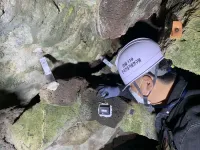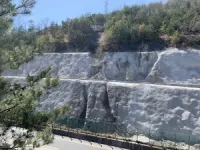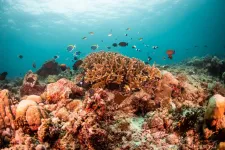KICT develops a ground & structure collapse detection sensor
A smart sensor and system capable of detecting imminent ground or structure collapses is now available
2023-03-28
(Press-News.org) The Korea Institute of Civil Engineering and Building Technology (KICT, President Kim Byung-suk) developed a smart sensor that detects signs of ground or structure collapses and a real-time remote monitoring system.
The development of the sensor and system began with a search for a method of instant sensing of the collapse of slopes or buildings caused by ground movement for immediate response. This led to the development of a smart sensor that turns on a LED warning light upon detecting ground movement. The existing systems that measure the ground movement are not widely used because they are intended for use by experts and are costly and difficult to use.
Dr. Baek, Yong at the Department of Geotechnical Engineering Research at KICT, thermal camera & image sensor venture company “emtake”, and KICT’s 1st Research-based Spin-off Company “JAK Co., Ltd”, jointly developed highly-efficient entry-level sensors and systems that can be deployed for continuous monitoring of ground movement in high-risk areas.
The sensors can be easily installed 1m ~ 2m apart in areas susceptible to collapses. They detect changes in slope as subtle as 0.03°. Upon sensing signs of a collapse, they immediately turn on an LED light to give a warning. The sensors have highly-efficient optical transmitting lens technology, so the LED alert is visible to the naked eye even at a distance of 100 meters at day or night. When the warning light turns on, those in the situation room can remotely ascertain what is happening in the affected area in real time. This helps them take additional measures such as sharing the developments of the collapse with the appropriate authorities.
The sensors are much easier to install and cost much less than the existing sensors, and their cost of installation and operation are more than 50% lower. What is more, they can run almost a year without battery replacement thanks to their ultra-low power consumption. The sensors are expected to be widely used in areas with distinct seasonal variations because they endure and function well even at extreme temperatures of −30℃ to 80℃.
To prevent false alarms, an algorithm in the sensors analyzes and evaluates the risk based on the conditions of the monitored locations. The sensors can be used at sites of construction, public works, tunneling work, dilapidated buildings, and historical properties, as well as mines, underground structures, areas susceptible to landslides, and so forth.
The sensors were installed on a pilot basis in lava tubes on Jejudo Island, cut slopes alongside national roads and slopes in mountainous areas, and alongside the GTX-A high-speed railways in the Seoul metropolitan area. It is expected that they will be installed at more and more sites of major construction projects as well as building demolitions.
Dr. Baek said, “The current detection technology cannot respond very quickly to a collapse because it takes so much time to analyze and interpret the data.”“This new sensor technology will greatly reduce the time to take action and, therefore, do a great deal to help prevent and respond to collapses,” he added.
This achievement is the outcome of research related to the “Development of A Countermeasure System against Jeju-type Subsidence for Safe Roads (from 2020 to 2022)” task, one of the KICT’s major projects (a project for inter-regional cooperation), supported by the Ministry of Science and ICT.
###
The Korea Institute of Civil Engineering and Building Technology (KICT) is a government sponsored research institute established to contribute to the development of Korea’s construction industry and national economic growth by developing source and practical technology in the fields of construction and national land management.
This paper is the outcome of research related to the “Development of A Countermeasure System against Jeju-type Subsidence for Safe Roads (from 2020 to 2022)” task, one of the KICT’s major Research Program (a project for inter-regional cooperation, project no. 2022-186), supported by the Ministry of Science and ICT.
END
[Attachments] See images for this press release:


ELSE PRESS RELEASES FROM THIS DATE:
2023-03-28
Replacement per- and polyfluoroalkyl substances (PFAS) heralded as safe for use in food packaging break down into toxic PFAS that leak into our food and environment, suggests a study published today in Environmental Science & Technology Letters.
Due to the known exposure risks of using smaller PFAS molecules like PFOA and PFOS in food-contact materials, many companies have pivoted to using larger polymeric PFAS to make their wrappers, bowls, and other fast-food packaging water- and grease-repellant. ...
2023-03-28
Gaithersburg, MD—March 28, 2023 – Cartesian Therapeutics, a fully integrated biopharmaceutical company pioneering RNA cell therapy for autoimmune diseases and cancer, today announced the appointment of five internationally recognized experts in autoimmune diseases. Cartesian’s appointments include distinguished physicians and scientists as leaders in clinical trials and medicine.
“Cartesian is proud to have these prestigious, multidisciplinary advisors committed to treating other autoimmune diseases,” said Miloš Miljković, M.D., Chief Medical Officer at Cartesian Therapeutics. “Their perspectives will provide the utmost value ...
2023-03-28
Researchers at the University of Toronto, Indiana University and University of Notre Dame have detected levels of toxic PFAS chemicals—short for per- and polyfluoroalkyl substances—for the first time in Canadian fast-food packaging, specifically water-and-grease repellent paper alternatives to plastic.
Published today in Environmental Science and Technology Letters, the findings suggest that food packaging exposes people directly to PFAS, which have been linked to serious health effects such as increased cancer risk and immune system damage, by contaminating the food they eat. Further, once discarded packaging enters waste streams, PFAS enter the environment, where these ...
2023-03-28
HOUSTON – (March 28, 2023) – The road to a net-zero future must be paved with greener concrete, and Rice University scientists know how to make it.
The production of cement, an ingredient in concrete, accounts for roughly 8% of the world’s annual carbon dioxide emissions, making it a significant target of greenhouse gas emissions reduction goals. Toward those efforts, the Rice lab of chemist James Tour used flash Joule heating to remove toxic heavy metals from fly ash, a powdery ...
2023-03-28
CHAMPAIGN, Ill. — As new environmental regulations are rolling out to mitigate the industry-retired long-chain chemicals known as PFAS in drinking water, there are concerns regarding a new breed of “forever chemicals” called short-chain PFAS. Research from the University of Illinois Urbana-Champaign is helping shift the focus to include mitigation of the chemicals – which researchers say are just as persistent as, more mobile and harder to remove from the environment than their long-chain counterparts.
A ...
2023-03-28
SAN FRANCISCO, CA (March 28, 2023) — In a paper published today in the journal Environmental Research Letters, an international research team composed of scientists affiliated with more than a dozen institutions, including the California Academy of Sciences, propose a first-of-its-kind framework for governments around the world to evaluate their preparedness for—and guide future policies to address—ocean acidification, among the most dire threats to marine ecosystems.
“Ocean acidification is one of climate change’s silent killers,” says Rebecca Albright, PhD, Academy Curator of Invertebrate Zoology and ...
2023-03-28
In North America’s hottest, driest desert, climate change is causing the decline of plants once thought nearly immortal and replacing them with shorter shrubs that can take advantage of sporadic rainfall and warmer temperatures.
Many studies have documented how a hotter, drier world is causing a redistribution of plants in temperate mountain regions. A new UC Riverside study documents the unexpected ways plants in part of the Sonoran Desert are doing the same.
“The plants ...
2023-03-28
INDIANAPOLIS, March 28, 2023 — Colorful particles of plastic drift along under the surface of most waterways, from headwater streams to the Arctic Ocean. These barely visible microplastics — less than 5 mm wide — are potentially harmful to aquatic animals and plants, as well as humans. So, researchers are devising ways to remove them and to stop them at their source. Today, a team reports a two-stage device made with steel tubes and pulsing sound waves that removes most of the plastic particles from real water samples.
The researchers will present ...
2023-03-28
INDIANAPOLIS, March 28, 2023 — The ancient art of origami is well known for transforming sheets of paper and other foldable materials into complex 3D shapes. But now, chemical engineers have extended the centuries-old practice to produce intricate shapes made of glass or other hard materials. Their thoroughly modern method, which can be combined with 3D printing, could have applications ranging from sculpture to catalysis and beyond.
The researchers will present their results today at the spring meeting of the American Chemical Society (ACS). ACS Spring 2023 is a hybrid meeting being held virtually and in-person ...
2023-03-28
INDIANAPOLIS, March 28, 2023 — There’s been a recent push in the U.S. to make naloxone — a fast-acting opioid antidote — available without a prescription. This medication has saved lives, but it’s less effective against powerful synthetic opioids, such as fentanyl. In an interesting twist, researchers are now looking to cannabidiol (CBD), a component of marijuana, as a possible alternative to the popular antidote. Today, a team reports compounds based on CBD that reduce fentanyl binding and boost the effects of naloxone.
The researchers will present their results at the spring meeting of the American Chemical Society (ACS). ...
LAST 30 PRESS RELEASES:
[Press-News.org] KICT develops a ground & structure collapse detection sensor
A smart sensor and system capable of detecting imminent ground or structure collapses is now available









